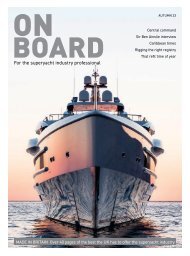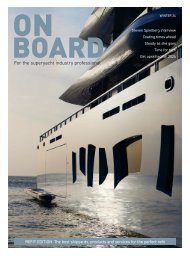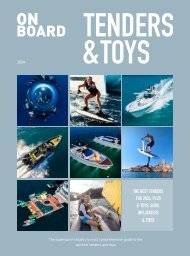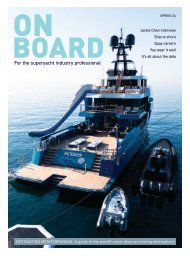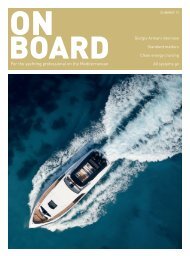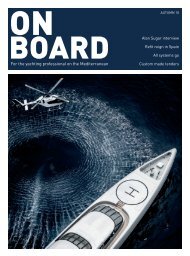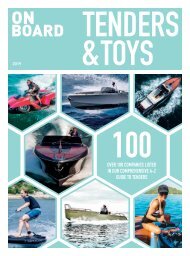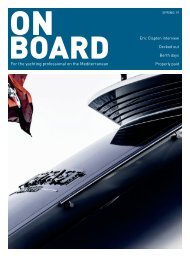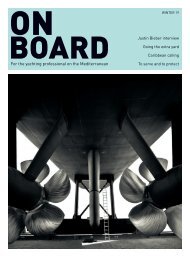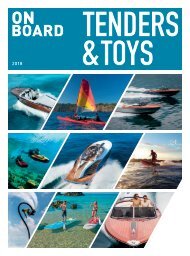ONBOARD Magazine - spring 2023
Get Onboard ONBOARD is aimed purely at the superyacht professional – whether onboard or shoreside. 100% of your spend will hit your targets on the Mediterranean from Palma in Mallorca, Barcelona, through France to Genoa and beyond together with Montenegro and the Aegean, plus the eastern seaboard of Florida. We hand deliver every copy to superyachts over 30m to make sure your message gets in to the hands of the decision makers on board. The publication is also delivered to relevant businesses around the ports and marinas together with shipyards. We also attend the major yacht shows in Monaco, FLIBS, METS, Boote Dusseldorf, Palma and MYBA for on site distribution. Plus, we post over 500 copies to relevant businesses not on the Mediterranean such as the UK, the Netherlands, Germany the rest of northern Europe and of course the USA and Caribbean. We work hard to develop a publication that all the crew and land based decision makers will read from cover to cover. An enjoyable and informative read for everyone means your message will be read. Talking about your brand, product, services and your team is essential and with our help, the message hits the right decision makers.
Get Onboard
ONBOARD is aimed purely at the superyacht professional – whether onboard or shoreside. 100% of your spend will hit your targets on the Mediterranean from Palma in Mallorca, Barcelona, through France to Genoa and beyond together with Montenegro and the Aegean, plus the eastern seaboard of Florida. We hand deliver every copy to superyachts over 30m to make sure your message gets in to the hands of the decision makers on board.
The publication is also delivered to relevant businesses around the ports and marinas together with shipyards. We also attend the major yacht shows in Monaco, FLIBS, METS, Boote Dusseldorf, Palma and MYBA for on site distribution. Plus, we post over 500 copies to relevant businesses not on the Mediterranean such as the UK, the Netherlands, Germany the rest of northern Europe and of course the USA and Caribbean.
We work hard to develop a publication that all the crew and land based decision makers will read from cover to cover. An enjoyable and informative read for everyone means your message will be read.
Talking about your brand, product, services and your team is essential and with our help, the message hits the right decision makers.
You also want an ePaper? Increase the reach of your titles
YUMPU automatically turns print PDFs into web optimized ePapers that Google loves.
COMMENT<br />
Dust off your sextant<br />
Captain Michael Howorth muses on how every once in a while it might<br />
be good to get back to navigational basics and shoot the sun<br />
I recently enjoyed the hospitality of a superyacht as she crossed<br />
from the Mediterranean to the Caribbean at the start of her<br />
winter charter season. For me, it was a wonderful opportunity<br />
to get my sea legs back and polish my watchkeeping skills which<br />
were in serious danger of going rusty. So, I am particularly<br />
grateful to the yacht’s owner, his Captain Sean Read and the<br />
crew of the motor yacht, Triumph for the wonderful opportunity<br />
of sailing transatlantic.<br />
It was while I was standing the forenoon watch and searching<br />
the empty horizon for ships that were not there, that I chanced<br />
upon the yacht’s sextant tucked away in a locker on the bridge.<br />
A contemporary, lightweight example, it was nowhere near as<br />
heavy or as beautifully crafted as the Tamaya I purchased in<br />
1970 when I first qualified as an OOW.<br />
But it did the job and I amused myself<br />
in shooting the sun and bringing its<br />
image down so that its lower limb kissed<br />
the horizon 13 miles away. I got the<br />
almanac out and worked out the time<br />
of Mer Alt, the exact time when the<br />
sun reaches its zenith in that latitude.<br />
But I didn’t calculate the intercept nor<br />
draw the position line on the plotting<br />
chart in the fashion I had been taught<br />
as a deck cadet sailing in the liners of<br />
the mighty Peninsular and Orient Line all those years ago. The<br />
fact is I had forgotten how to do so!<br />
Back in the day before we had electronic navigation, I was used to<br />
shooting the sun 5 times during the 8 – 12 watch. I had only my<br />
log tables and (if the captain was not looking) my slide rule to do<br />
the calculations. We were never allowed to use sight reduction<br />
tables for sun shots but did so each morning and evening when<br />
shooting stars. Standing on the bridge of Triumph, I was so<br />
appalled by my loss of memory and my inability to carry out a<br />
task I had done so frequently as a youth that I devoted the rest<br />
of my passage sailing towards Antigua using the examples in the<br />
front of the almanac and the log tables. By the time we passed<br />
I amused myself in<br />
shooting the sun and<br />
bringing its image down<br />
so that its lower limb<br />
kissed the horizon<br />
Pidgeon Point and entered Falmouth, I was back to speed and<br />
feeling rather proud of myself.<br />
Since the commissioning of the Global Navigation Satellite System<br />
(GNSS), its proven accuracy and reliability in all weather conditions<br />
have resulted in confidence and almost unquestioning dependence<br />
on its ability to provide a vessel’s position, course, and speed.<br />
Because of this, its use is widespread, and some seafarers<br />
feel that the traditional navigational methods are obsolete. One<br />
might ask why ships should still be required to carry navigation<br />
equipment and publications.<br />
The marine environment is a hostile one and failure of electronic<br />
equipment is a constant possibility. Currently solar activity is<br />
increasing with the possibility of severe<br />
solar storms affecting GNSS accuracy<br />
or damaging satellites. The possibility<br />
of such failure should ensure that no<br />
prudent seafarer would proceed on<br />
an ocean passage without a reliable<br />
navigational back-up.<br />
Since J W Norie published the first edition<br />
of his Complete Set of Nautical Tables<br />
and Epitome of Practical Navigation<br />
in 1803, many changes to the tables<br />
have been necessary in both content and presentation. New<br />
tables have been included, obsolete ones deleted to conform<br />
with changing techniques of navigation, with the aim of improving<br />
the accuracy of the calculated position and reducing the tedium<br />
of the calculation.<br />
Norie still publish these tables and they do so because one day<br />
you might – just might – have need of them. So next time you<br />
have a spare moment when out at sea, dust off the sextant<br />
and keep your hand in. If you can’t remember how to do it, find<br />
an old fart like me and ask him if he would like to sail across the<br />
Atlantic and show the deckies how it is done. I would jump at<br />
the chance to do it again!<br />
<strong>ONBOARD</strong> | SPRING <strong>2023</strong> | 5




